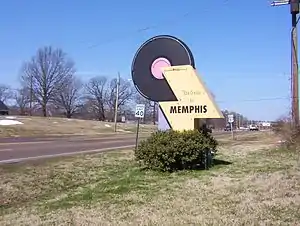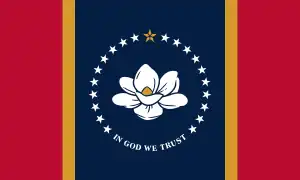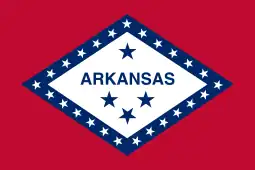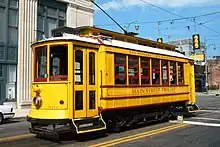Arlington, Tennessee
Arlington is a town in Shelby County, Tennessee, United States. The population was 2,569 at the 2000 census, 11,517 at the 2010 census,[5] and 14,549 at the 2020 Census.[6] From 2010 until 2020 the town's population grew by 26.326%. It is one of the seven municipalities in Shelby County. The town lies wholly within the borders of Shelby County.[7]
Arlington, Tennessee | |
|---|---|
 Location of Arlington in Shelby County, Tennessee. | |
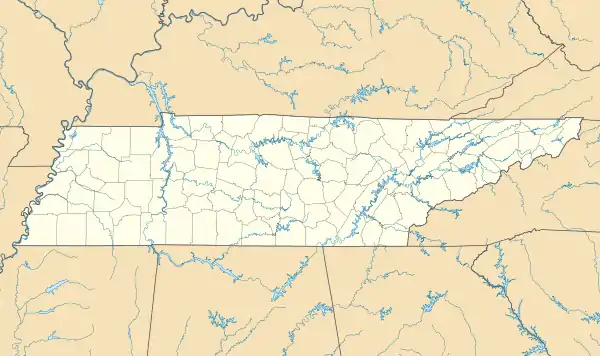 Arlington  Arlington  Arlington | |
| Coordinates: 35°16′40″N 89°40′24″W | |
| State | Tennessee |
| County | Shelby |
| Government | |
| • Mayor | Mike Wissman |
| Area | |
| • Total | 23.16 sq mi (59.99 km2) |
| • Land | 23.15 sq mi (59.96 km2) |
| • Water | 0.01 sq mi (0.03 km2) |
| Elevation | 282 ft (86 m) |
| Population | |
| • Total | 14,549 |
| • Density | 628.47/sq mi (242.65/km2) |
| Time zone | UTC-6 (Central (CST)) |
| • Summer (DST) | UTC-5 (CDT) |
| ZIP code | 38002, 38028 |
| Area code | 901 |
| FIPS code | 47-01740[3] |
| GNIS feature ID | 1304869[4] |
| Website | www.townofarlington.org |
Government
Arlington "follows a general law Mayor-Alderman charter" according to the official website of the town.[8] The current mayor is Mike Wissman. Arlington has six alderman.[8]
History
Settlers came to the area in the 1830s, and many of their descendants still live in the town. Originally known as Haysville,[9] the town was named after the original landowner, Samuel Jackson Hays, a nephew of President Andrew Jackson. The area began to grow with the development of the Memphis and Ohio Railroad and the creation of Withe Depot within its boundaries. By 1856, about 200 people called Haysville home. The outbreak of yellow fever in Memphis in 1878 contributed to the stagnant population as the town fathers quarantined the area, forbidding outsiders from entering the town. The town was incorporated as Haysville in 1878.[9]
In 1883 the town's name was changed to Arlington due to the post office being unable to use the name Haysville. Captain Henry Pittman, who lived in Haysville, had visited Washington, D.C., and Arlington National Cemetery and was inspired to call the town Arlington.[9]
In 1900 the town was incorporated again.
The economic crash of 1929 led to a small economic depression in the town, but Arlington's economy gradually grew out of it due to the major change of highway 70 opening the town to outside businesses.[10]
The towns first school was opened up in 1884. "Memphis District High School", which was located on what is now known as "College Hill."[11] The school only taught up to a high school level, but locally it was named "The College".
Arlington has a range of historical buildings that bring its past into view for all interested parties. Starting with the Rachel H.K. Museum, which is a museum in Arlington that has historical pieces of Arlington. Next is Arlington's Blacksmith shop. There are fewer than 1,000 nationwide, and Arlington's is an important one to the small town’s history. It was made in the 1800s and still is put to use during certain events throughout the year.[8]
Geography
According to the United States Census Bureau, the town has a total area of 20.4 square miles (53 km2), of which 0.05% is water.[12]
Demographics
| Census | Pop. | Note | %± |
|---|---|---|---|
| 1890 | 343 | — | |
| 1910 | 477 | — | |
| 1920 | 494 | 3.6% | |
| 1930 | 446 | −9.7% | |
| 1940 | 440 | −1.3% | |
| 1950 | 463 | 5.2% | |
| 1960 | 620 | 33.9% | |
| 1970 | 1,349 | 117.6% | |
| 1980 | 1,778 | 31.8% | |
| 1990 | 1,541 | −13.3% | |
| 2000 | 2,569 | 66.7% | |
| 2010 | 11,517 | 348.3% | |
| 2020 | 14,549 | 26.3% | |
| Sources:[13][14][2] | |||
2020 Census
| Race | Num. | Perc. |
|---|---|---|
| White (non-Hispanic) | 10,719 | 73.68% |
| Black or African American (non-Hispanic) | 1,916 | 13.17% |
| Native American | 39 | 0.27% |
| Asian | 342 | 2.35% |
| Pacific Islander | 11 | 0.08% |
| Other/Mixed | 745 | 5.12% |
| Hispanic or Latino | 777 | 5.34% |
As of the 2020 United States census, there were 14,549 people, 3,560 households, and 3,046 families residing in the town.
2010 Census
At the 2010 census there were 11,517 people, and 3,739 households. The population density was 565 inhabitants per square mile (218/km2). The racial makeup of the town was 81.24% White, 13.84% African American, 0.16% Native American, 1.80% Asian, 0.86% from other races, 2.08% from two or more races, and .02% from Native Hawaiian and Other Pacific Islander. Hispanic or Latino of any race were 2.98%.[3][16]
Of the 3,907 households 35.23% were 1-2 person occupied, 48.02% were 3-4 person occupied, 15.32% were 5-6 person occupied, 1.42% were 7 or more person households and 4.2% were listed as unoccupied. With the 3,907 households owned in Arlington, they are estimated to have a median value of $217,300.[17]
The age distribution was 37.53% under the age of 18, 3.47% from 18 to 24, 35.62% from 25 to 44, 19.20% from 45 to 64, and 4.19% 65 or older.[18] The median age was 32.2 years. The population was 49% male and 51% female.
From 2013 to 2017, Arlington's estimated household income was predicted to be $99,404.[19] This has increased since 2009, when the household income was estimated to be $85,779.
2000 Census
At the 2000 census there were 2,569 people, 794 households, and 669 families in the town. The population density was 125.8 inhabitants per square mile (48.6/km2). There were 928 housing units at an average density of 45.4 per square mile (17.5/km2). The racial makeup of the town was 74.23% White, 23.01% African American, 0.47% Native American, 0.62% Asian, 0.54% from other races, and 1.13% from two or more races. Hispanic or Latino of any race were 1.13%.[3]
Of the 794 households 42.8% had children under the age of 18 living with them, 67.1% were married couples living together, 13.5% had a female householder with no husband present, and 15.7% were non-families. 12.2% of households were one person and 5.7% were one person aged 65 or older. The average household size was 2.88 and the average family size was 3.15.
The age distribution was 26.1% under the age of 18, 5.8% from 18 to 24, 37.6% from 25 to 44, 22.6% from 45 to 64, and 8.0% 65 or older. The median age was 36 years. For every 100 females, there were 97.5 males. For every 100 females age 18 and over, there were 92.8 males.
The median household income was $52,870 and the median family income was $55,602. Males had a median income of $38,438 versus $29,138 for females. The per capita income for the town was $19,569. About 3.1% of families and 11.3% of the population were below the poverty line, including 4.4% of those under age 18 and 23.2% of those age 65 or over.
Education
Arlington is served by Arlington Community Schools and Shelby County Schools.
Arlington boasts having a student-teacher ratio of 18 to 1.[17]
There are four schools located within the municipality of Arlington:
- Arlington Elementary School K-5
- Donelson Elementary School K-5
- Arlington Middle School 6-8
- Arlington High School 9-12
Arlington Community schools was created in 2014, and it started with an enrollment of 4907 kids.[20]
There are two schools in Arlington served by Shelby County Schools:
- Barret's Chapel School (K-8, Shelby County Schools)
- Bolton High School 9-12
References
- "ArcGIS REST Services Directory". United States Census Bureau. Retrieved October 15, 2022.
- "Census Population API". United States Census Bureau. Retrieved October 15, 2022.
- "U.S. Census website". United States Census Bureau. Retrieved January 31, 2008.
- "US Board on Geographic Names". United States Geological Survey. October 25, 2007. Retrieved January 31, 2008.
- "Race, Hispanic or Latino, Age, and Housing Occupancy: 2010 Census Redistricting Data (Public Law 94-171) Summary File (QT-PL), Arlington town, Tennessee". United States Census Bureau. Retrieved August 17, 2011.
- "Explore Census Data". data.census.gov. Retrieved April 15, 2022.
- "Town of Arlington Comprehensive Plan" (PDF). Future Land Use Plan Map. January 2020. Retrieved October 1, 2023.
- "Welcome to Town of Arlington, Tennessee". www.townofarlington.org. Retrieved December 3, 2019.
- Larry L. Miller (October 2001). Tennessee place names. Indiana University Press. p. 8. ISBN 978-0-253-21478-2. Retrieved November 21, 2011.
- MANTECH SERVICES CORP ARLINGTON VA (September 10, 1993). "Site-Survey Plan for the ASCAN Project". Fort Belvoir, VA. doi:10.21236/ada373384.
{{cite journal}}: Cite journal requires|journal=(help) - BURROW, JOHN (1962). "SHORT NOTICES". The Review of English Studies. XIII (50): 216–b–217. doi:10.1093/res/xiii.50.216-b. ISSN 0034-6551.
- "US Gazetteer files: 2010, 2000, and 1990". United States Census Bureau. February 12, 2011. Retrieved April 23, 2011.
- "Census of Population and Housing: Decennial Censuses". United States Census Bureau. Retrieved March 4, 2012.
- "Incorporated Places and Minor Civil Divisions Datasets: Subcounty Resident Population Estimates: April 1, 2010 to July 1, 2012". Population Estimates. U.S. Census Bureau. Archived from the original on June 11, 2013. Retrieved December 11, 2013.
- "Explore Census Data". data.census.gov. Retrieved December 8, 2021.
- "Arlington, TN Population - Census 2010 and 2000 Interactive Map, Demographics, Statistics, Quick Facts - CensusViewer". Archived from the original on June 15, 2013. Retrieved June 18, 2013.
- PolicyMap. July 23, 2013. S2CID 242341644.
- "Archived copy". Archived from the original on July 4, 2014. Retrieved June 18, 2013.
{{cite web}}: CS1 maint: archived copy as title (link) - Bureau, US Census. "Census.gov". Census.gov. Retrieved December 3, 2019.
- Siegel-Hawley, Genevieve; Diem, Sarah; Frankenberg, Erica (March 5, 2018). "The Disintegration of Memphis-Shelby County, Tennessee: School District Secession and Local Control in the 21st Century". American Educational Research Journal. 55 (4): 651–692. doi:10.3102/0002831217748880. ISSN 0002-8312. S2CID 148748219.
